BAFN205 Financial Instruments: Analysis of Australian Institutions
VerifiedAdded on 2023/04/06
|13
|1910
|475
Report
AI Summary
This report provides an overview of Australian financial institutions as classified by the Reserve Bank of Australia, analyzing authorized deposit-taking institutions, non-ADI financial institutions, insurers, and fund managers. It examines the performance of Commonwealth Bank using its 2018 annual report, focusing on earnings, revenue, expenses, and asset quality. The report also discusses the term structure of interest rates in Australia and its impact on bond and share valuations, highlighting the importance of accurate interest rate calculation models. Desklib provides access to this and other solved assignments for students.
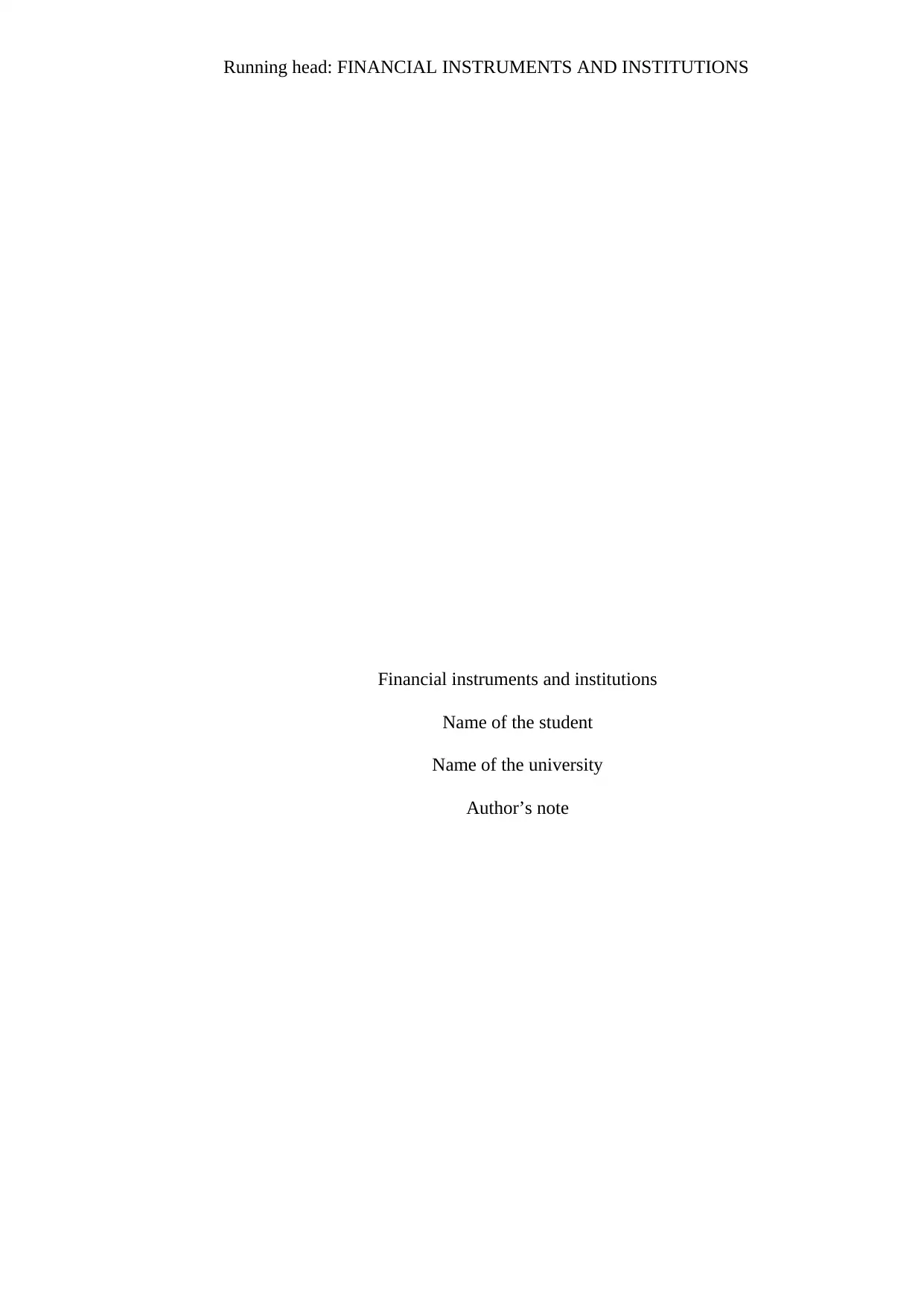
Running head: FINANCIAL INSTRUMENTS AND INSTITUTIONS
Financial instruments and institutions
Name of the student
Name of the university
Author’s note
Financial instruments and institutions
Name of the student
Name of the university
Author’s note
Paraphrase This Document
Need a fresh take? Get an instant paraphrase of this document with our AI Paraphraser
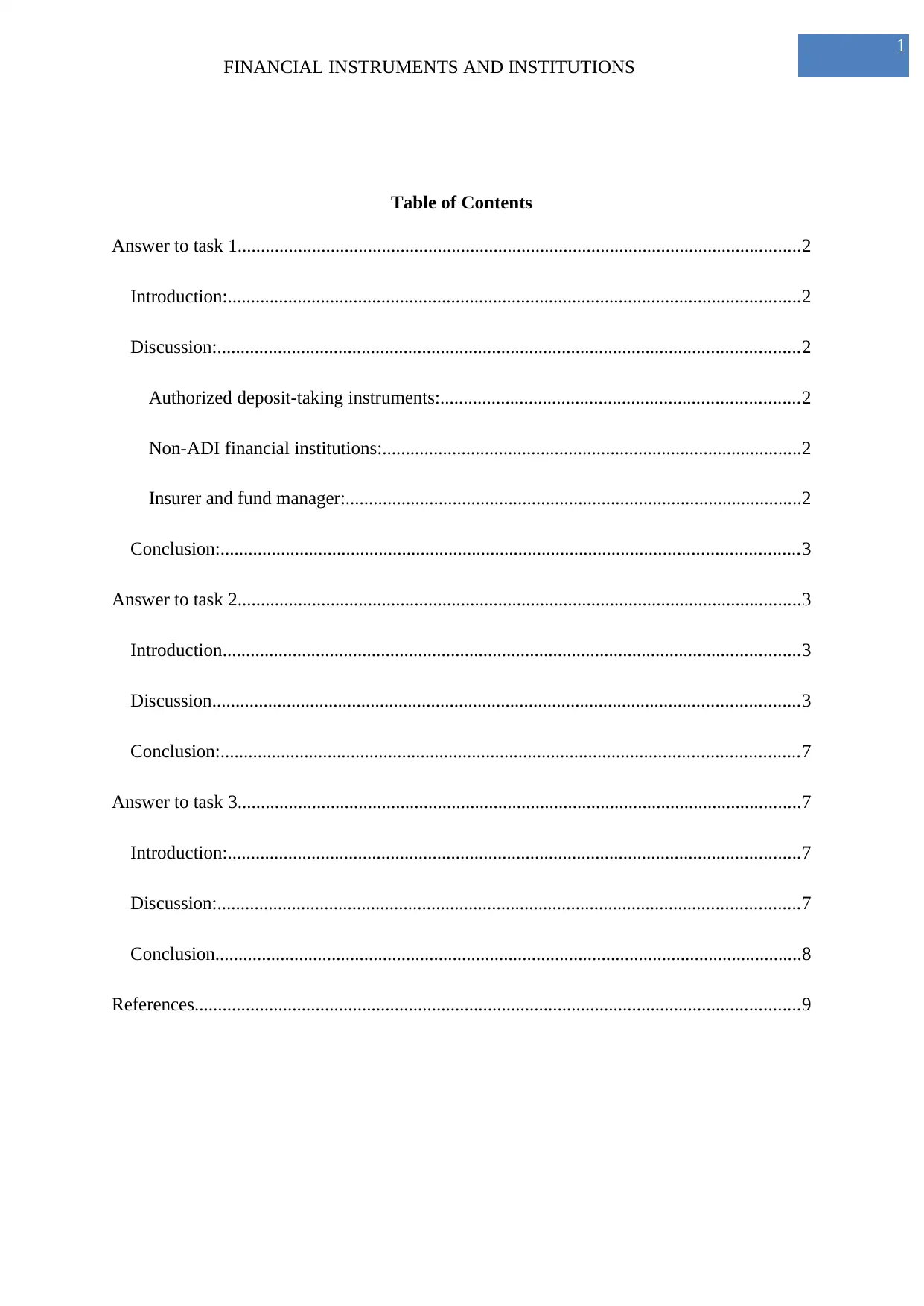
1
FINANCIAL INSTRUMENTS AND INSTITUTIONS
Table of Contents
Answer to task 1.........................................................................................................................2
Introduction:...........................................................................................................................2
Discussion:.............................................................................................................................2
Authorized deposit-taking instruments:.............................................................................2
Non-ADI financial institutions:..........................................................................................2
Insurer and fund manager:..................................................................................................2
Conclusion:............................................................................................................................3
Answer to task 2.........................................................................................................................3
Introduction............................................................................................................................3
Discussion..............................................................................................................................3
Conclusion:............................................................................................................................7
Answer to task 3.........................................................................................................................7
Introduction:...........................................................................................................................7
Discussion:.............................................................................................................................7
Conclusion..............................................................................................................................8
References..................................................................................................................................9
FINANCIAL INSTRUMENTS AND INSTITUTIONS
Table of Contents
Answer to task 1.........................................................................................................................2
Introduction:...........................................................................................................................2
Discussion:.............................................................................................................................2
Authorized deposit-taking instruments:.............................................................................2
Non-ADI financial institutions:..........................................................................................2
Insurer and fund manager:..................................................................................................2
Conclusion:............................................................................................................................3
Answer to task 2.........................................................................................................................3
Introduction............................................................................................................................3
Discussion..............................................................................................................................3
Conclusion:............................................................................................................................7
Answer to task 3.........................................................................................................................7
Introduction:...........................................................................................................................7
Discussion:.............................................................................................................................7
Conclusion..............................................................................................................................8
References..................................................................................................................................9
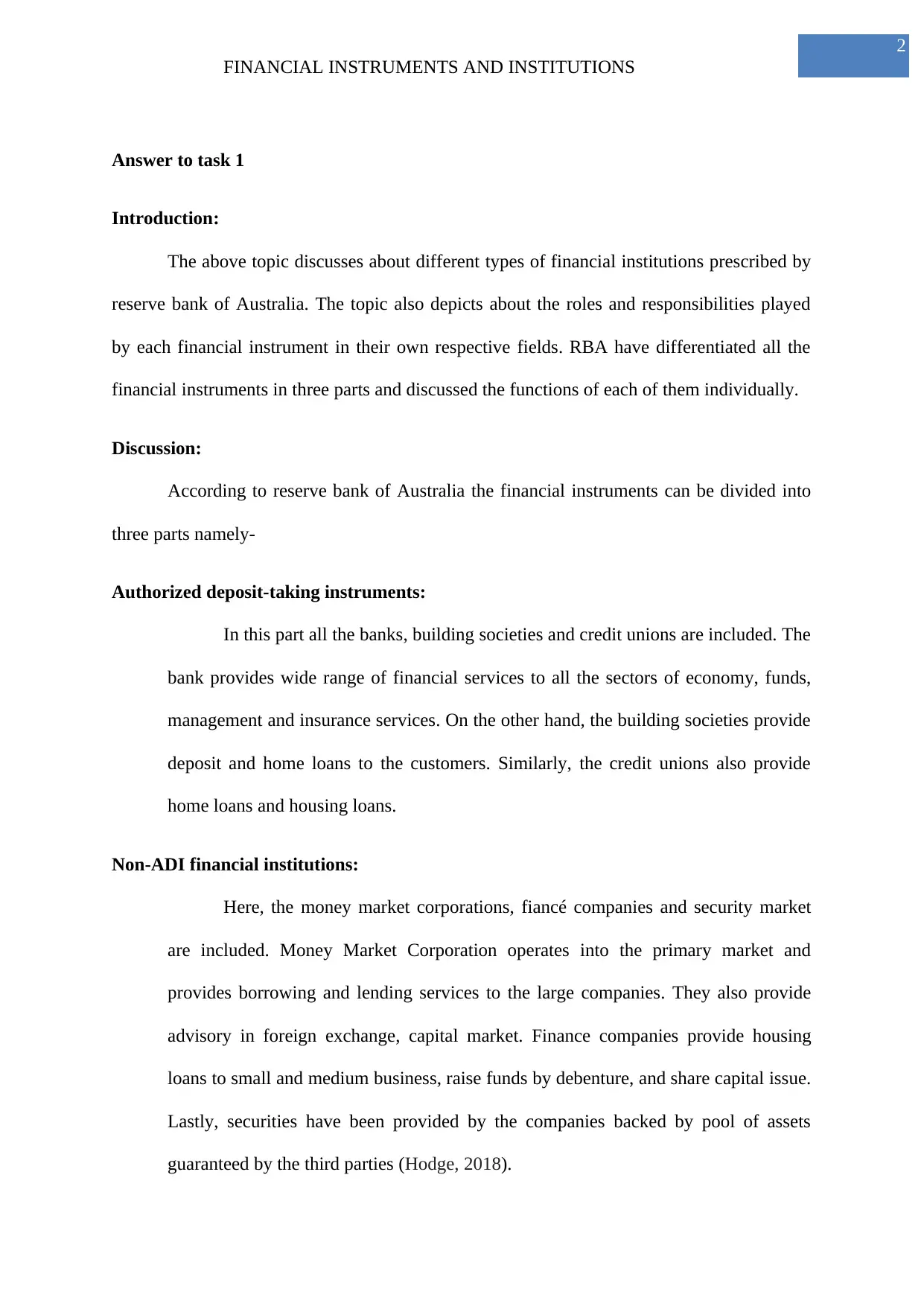
2
FINANCIAL INSTRUMENTS AND INSTITUTIONS
Answer to task 1
Introduction:
The above topic discusses about different types of financial institutions prescribed by
reserve bank of Australia. The topic also depicts about the roles and responsibilities played
by each financial instrument in their own respective fields. RBA have differentiated all the
financial instruments in three parts and discussed the functions of each of them individually.
Discussion:
According to reserve bank of Australia the financial instruments can be divided into
three parts namely-
Authorized deposit-taking instruments:
In this part all the banks, building societies and credit unions are included. The
bank provides wide range of financial services to all the sectors of economy, funds,
management and insurance services. On the other hand, the building societies provide
deposit and home loans to the customers. Similarly, the credit unions also provide
home loans and housing loans.
Non-ADI financial institutions:
Here, the money market corporations, fiancé companies and security market
are included. Money Market Corporation operates into the primary market and
provides borrowing and lending services to the large companies. They also provide
advisory in foreign exchange, capital market. Finance companies provide housing
loans to small and medium business, raise funds by debenture, and share capital issue.
Lastly, securities have been provided by the companies backed by pool of assets
guaranteed by the third parties (Hodge, 2018).
FINANCIAL INSTRUMENTS AND INSTITUTIONS
Answer to task 1
Introduction:
The above topic discusses about different types of financial institutions prescribed by
reserve bank of Australia. The topic also depicts about the roles and responsibilities played
by each financial instrument in their own respective fields. RBA have differentiated all the
financial instruments in three parts and discussed the functions of each of them individually.
Discussion:
According to reserve bank of Australia the financial instruments can be divided into
three parts namely-
Authorized deposit-taking instruments:
In this part all the banks, building societies and credit unions are included. The
bank provides wide range of financial services to all the sectors of economy, funds,
management and insurance services. On the other hand, the building societies provide
deposit and home loans to the customers. Similarly, the credit unions also provide
home loans and housing loans.
Non-ADI financial institutions:
Here, the money market corporations, fiancé companies and security market
are included. Money Market Corporation operates into the primary market and
provides borrowing and lending services to the large companies. They also provide
advisory in foreign exchange, capital market. Finance companies provide housing
loans to small and medium business, raise funds by debenture, and share capital issue.
Lastly, securities have been provided by the companies backed by pool of assets
guaranteed by the third parties (Hodge, 2018).
⊘ This is a preview!⊘
Do you want full access?
Subscribe today to unlock all pages.

Trusted by 1+ million students worldwide
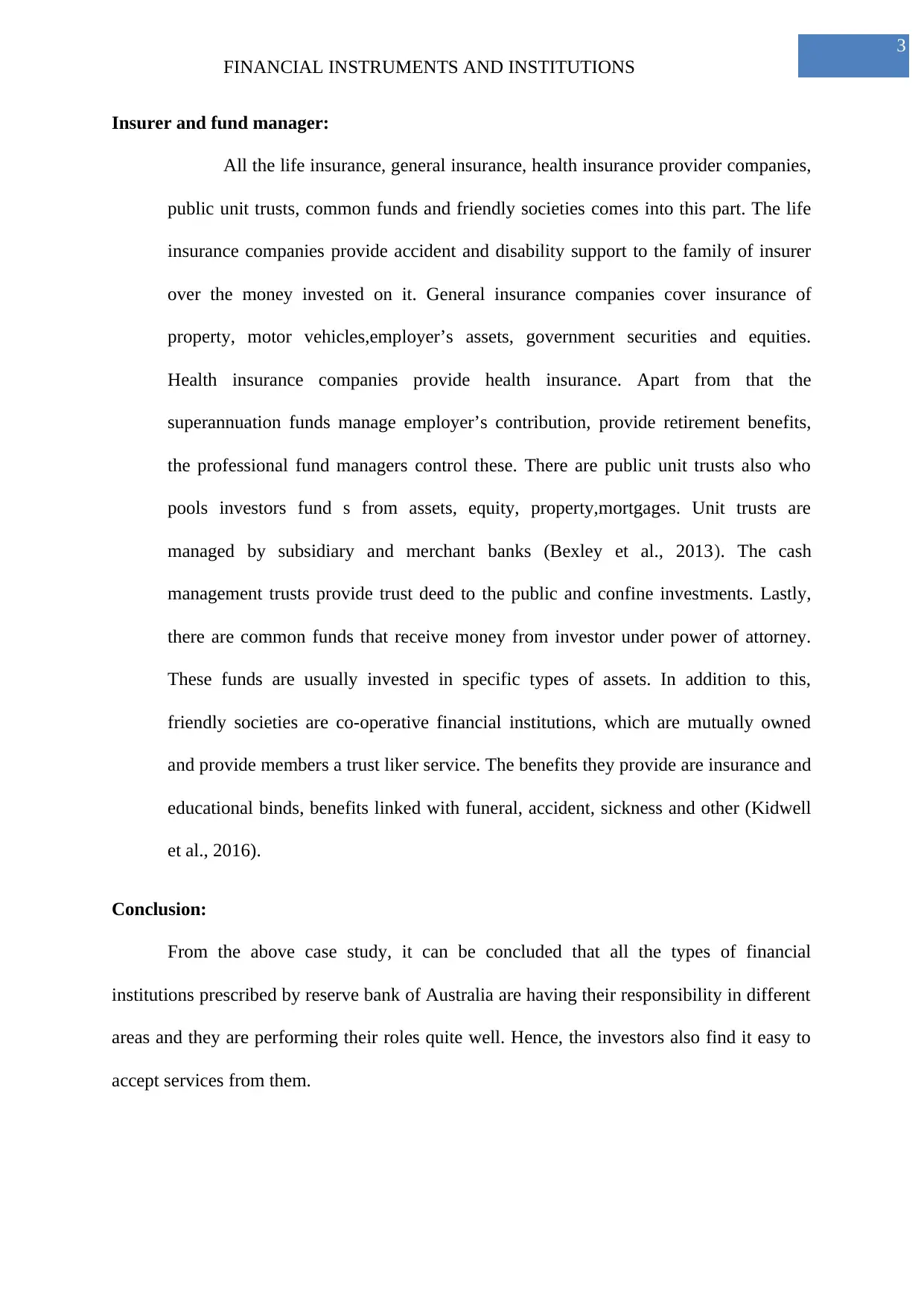
3
FINANCIAL INSTRUMENTS AND INSTITUTIONS
Insurer and fund manager:
All the life insurance, general insurance, health insurance provider companies,
public unit trusts, common funds and friendly societies comes into this part. The life
insurance companies provide accident and disability support to the family of insurer
over the money invested on it. General insurance companies cover insurance of
property, motor vehicles,employer’s assets, government securities and equities.
Health insurance companies provide health insurance. Apart from that the
superannuation funds manage employer’s contribution, provide retirement benefits,
the professional fund managers control these. There are public unit trusts also who
pools investors fund s from assets, equity, property,mortgages. Unit trusts are
managed by subsidiary and merchant banks (Bexley et al., 2013). The cash
management trusts provide trust deed to the public and confine investments. Lastly,
there are common funds that receive money from investor under power of attorney.
These funds are usually invested in specific types of assets. In addition to this,
friendly societies are co-operative financial institutions, which are mutually owned
and provide members a trust liker service. The benefits they provide are insurance and
educational binds, benefits linked with funeral, accident, sickness and other (Kidwell
et al., 2016).
Conclusion:
From the above case study, it can be concluded that all the types of financial
institutions prescribed by reserve bank of Australia are having their responsibility in different
areas and they are performing their roles quite well. Hence, the investors also find it easy to
accept services from them.
FINANCIAL INSTRUMENTS AND INSTITUTIONS
Insurer and fund manager:
All the life insurance, general insurance, health insurance provider companies,
public unit trusts, common funds and friendly societies comes into this part. The life
insurance companies provide accident and disability support to the family of insurer
over the money invested on it. General insurance companies cover insurance of
property, motor vehicles,employer’s assets, government securities and equities.
Health insurance companies provide health insurance. Apart from that the
superannuation funds manage employer’s contribution, provide retirement benefits,
the professional fund managers control these. There are public unit trusts also who
pools investors fund s from assets, equity, property,mortgages. Unit trusts are
managed by subsidiary and merchant banks (Bexley et al., 2013). The cash
management trusts provide trust deed to the public and confine investments. Lastly,
there are common funds that receive money from investor under power of attorney.
These funds are usually invested in specific types of assets. In addition to this,
friendly societies are co-operative financial institutions, which are mutually owned
and provide members a trust liker service. The benefits they provide are insurance and
educational binds, benefits linked with funeral, accident, sickness and other (Kidwell
et al., 2016).
Conclusion:
From the above case study, it can be concluded that all the types of financial
institutions prescribed by reserve bank of Australia are having their responsibility in different
areas and they are performing their roles quite well. Hence, the investors also find it easy to
accept services from them.
Paraphrase This Document
Need a fresh take? Get an instant paraphrase of this document with our AI Paraphraser
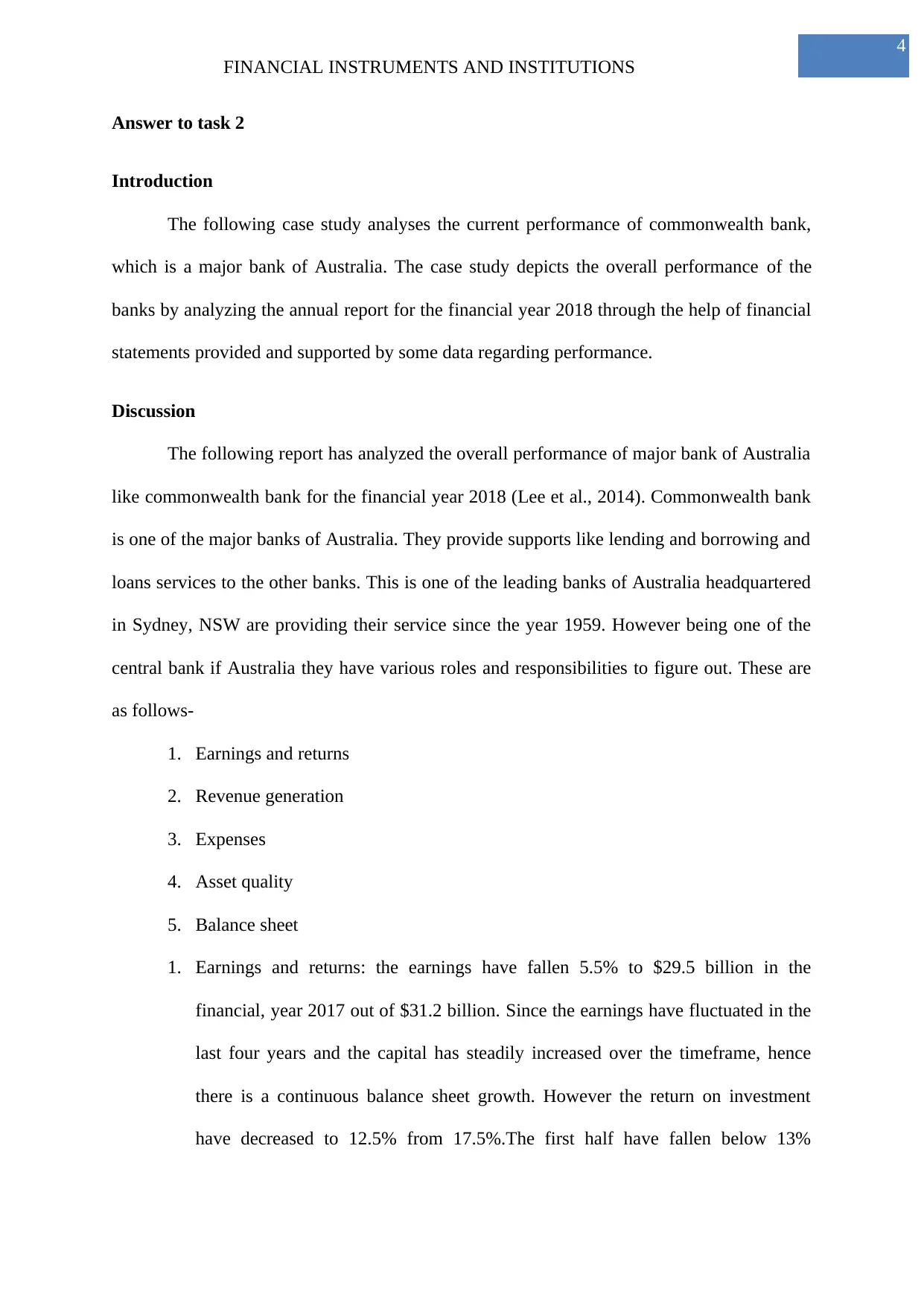
4
FINANCIAL INSTRUMENTS AND INSTITUTIONS
Answer to task 2
Introduction
The following case study analyses the current performance of commonwealth bank,
which is a major bank of Australia. The case study depicts the overall performance of the
banks by analyzing the annual report for the financial year 2018 through the help of financial
statements provided and supported by some data regarding performance.
Discussion
The following report has analyzed the overall performance of major bank of Australia
like commonwealth bank for the financial year 2018 (Lee et al., 2014). Commonwealth bank
is one of the major banks of Australia. They provide supports like lending and borrowing and
loans services to the other banks. This is one of the leading banks of Australia headquartered
in Sydney, NSW are providing their service since the year 1959. However being one of the
central bank if Australia they have various roles and responsibilities to figure out. These are
as follows-
1. Earnings and returns
2. Revenue generation
3. Expenses
4. Asset quality
5. Balance sheet
1. Earnings and returns: the earnings have fallen 5.5% to $29.5 billion in the
financial, year 2017 out of $31.2 billion. Since the earnings have fluctuated in the
last four years and the capital has steadily increased over the timeframe, hence
there is a continuous balance sheet growth. However the return on investment
have decreased to 12.5% from 17.5%.The first half have fallen below 13%
FINANCIAL INSTRUMENTS AND INSTITUTIONS
Answer to task 2
Introduction
The following case study analyses the current performance of commonwealth bank,
which is a major bank of Australia. The case study depicts the overall performance of the
banks by analyzing the annual report for the financial year 2018 through the help of financial
statements provided and supported by some data regarding performance.
Discussion
The following report has analyzed the overall performance of major bank of Australia
like commonwealth bank for the financial year 2018 (Lee et al., 2014). Commonwealth bank
is one of the major banks of Australia. They provide supports like lending and borrowing and
loans services to the other banks. This is one of the leading banks of Australia headquartered
in Sydney, NSW are providing their service since the year 1959. However being one of the
central bank if Australia they have various roles and responsibilities to figure out. These are
as follows-
1. Earnings and returns
2. Revenue generation
3. Expenses
4. Asset quality
5. Balance sheet
1. Earnings and returns: the earnings have fallen 5.5% to $29.5 billion in the
financial, year 2017 out of $31.2 billion. Since the earnings have fluctuated in the
last four years and the capital has steadily increased over the timeframe, hence
there is a continuous balance sheet growth. However the return on investment
have decreased to 12.5% from 17.5%.The first half have fallen below 13%
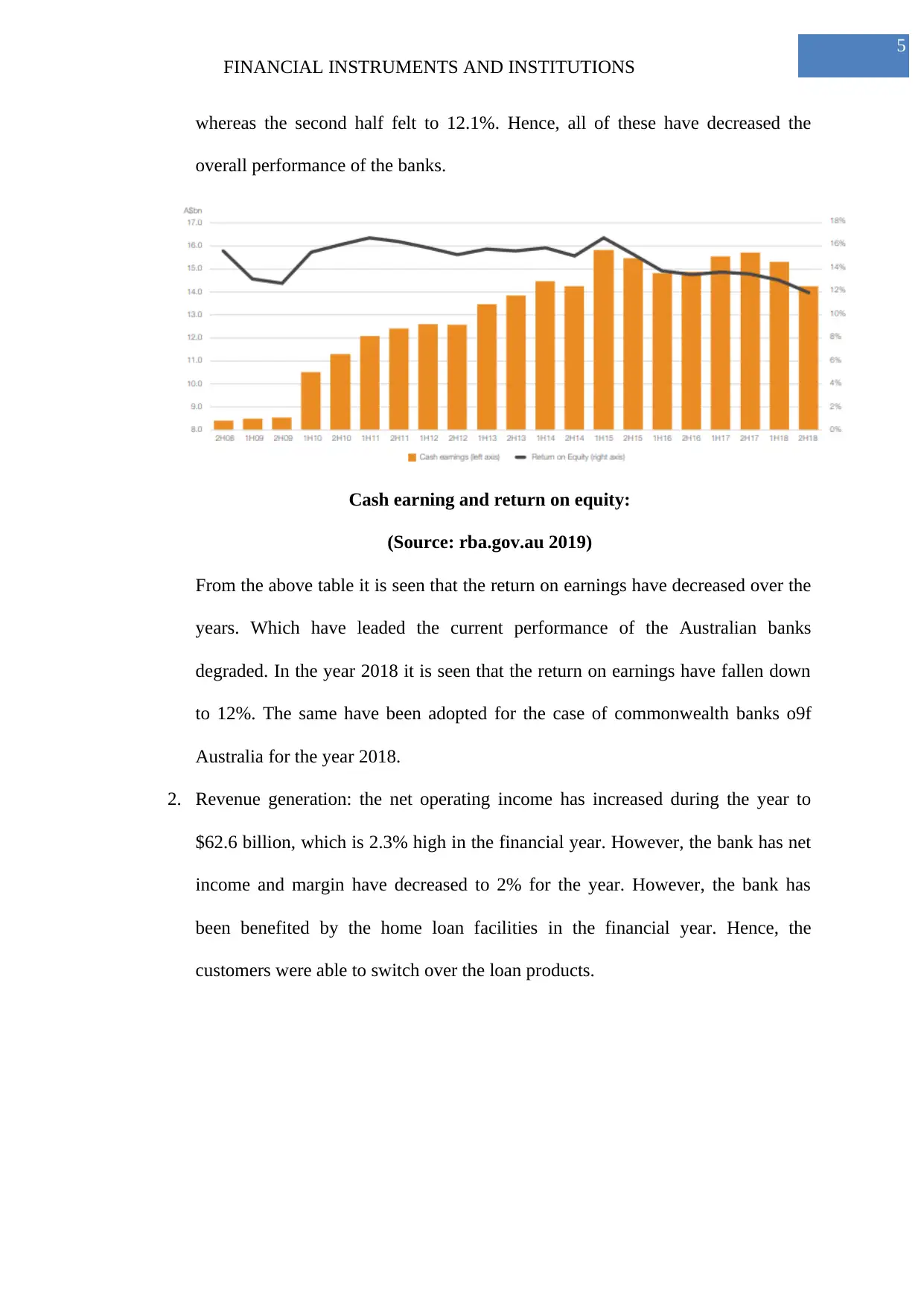
5
FINANCIAL INSTRUMENTS AND INSTITUTIONS
whereas the second half felt to 12.1%. Hence, all of these have decreased the
overall performance of the banks.
Cash earning and return on equity:
(Source: rba.gov.au 2019)
From the above table it is seen that the return on earnings have decreased over the
years. Which have leaded the current performance of the Australian banks
degraded. In the year 2018 it is seen that the return on earnings have fallen down
to 12%. The same have been adopted for the case of commonwealth banks o9f
Australia for the year 2018.
2. Revenue generation: the net operating income has increased during the year to
$62.6 billion, which is 2.3% high in the financial year. However, the bank has net
income and margin have decreased to 2% for the year. However, the bank has
been benefited by the home loan facilities in the financial year. Hence, the
customers were able to switch over the loan products.
FINANCIAL INSTRUMENTS AND INSTITUTIONS
whereas the second half felt to 12.1%. Hence, all of these have decreased the
overall performance of the banks.
Cash earning and return on equity:
(Source: rba.gov.au 2019)
From the above table it is seen that the return on earnings have decreased over the
years. Which have leaded the current performance of the Australian banks
degraded. In the year 2018 it is seen that the return on earnings have fallen down
to 12%. The same have been adopted for the case of commonwealth banks o9f
Australia for the year 2018.
2. Revenue generation: the net operating income has increased during the year to
$62.6 billion, which is 2.3% high in the financial year. However, the bank has net
income and margin have decreased to 2% for the year. However, the bank has
been benefited by the home loan facilities in the financial year. Hence, the
customers were able to switch over the loan products.
⊘ This is a preview!⊘
Do you want full access?
Subscribe today to unlock all pages.

Trusted by 1+ million students worldwide
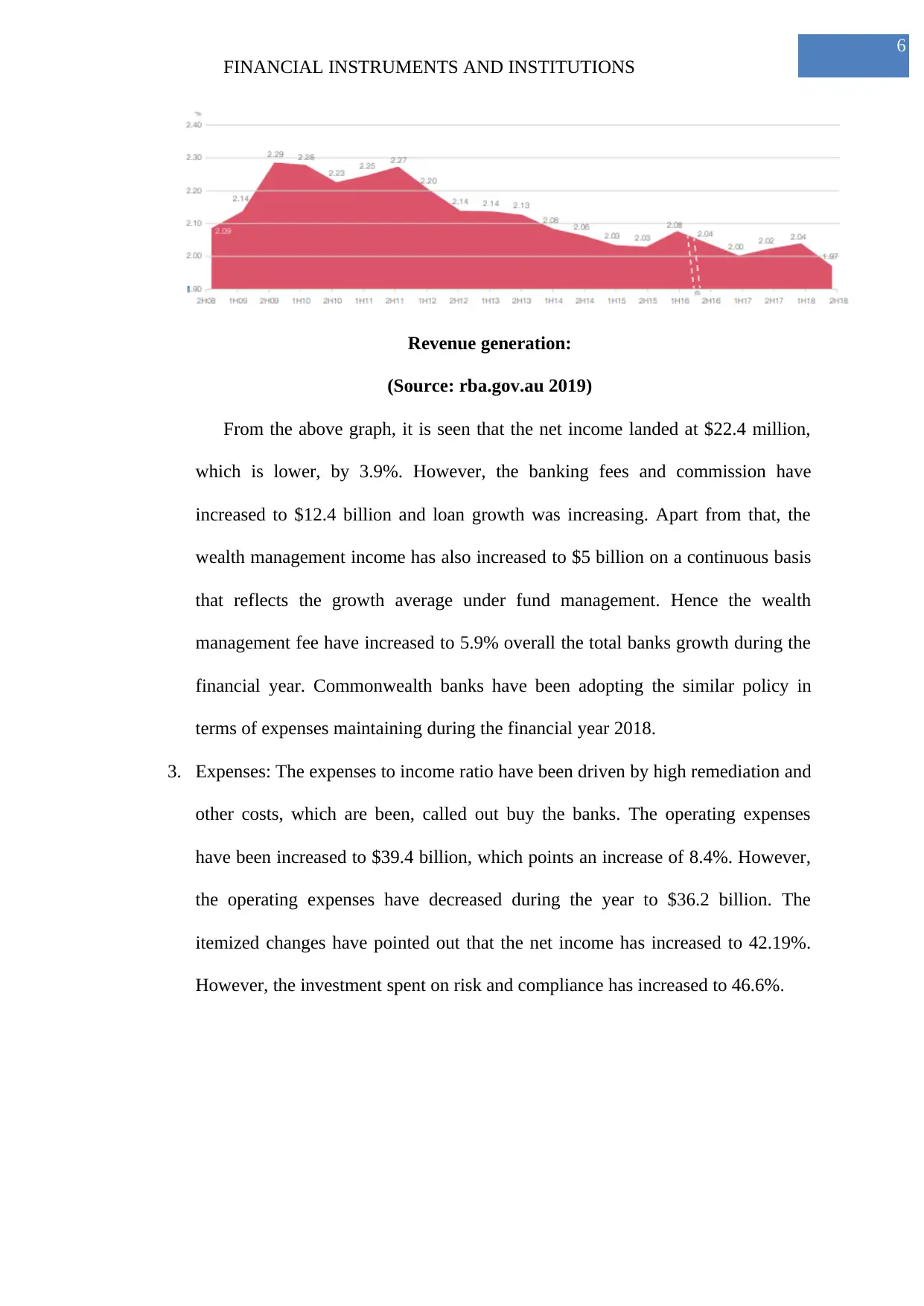
6
FINANCIAL INSTRUMENTS AND INSTITUTIONS
Revenue generation:
(Source: rba.gov.au 2019)
From the above graph, it is seen that the net income landed at $22.4 million,
which is lower, by 3.9%. However, the banking fees and commission have
increased to $12.4 billion and loan growth was increasing. Apart from that, the
wealth management income has also increased to $5 billion on a continuous basis
that reflects the growth average under fund management. Hence the wealth
management fee have increased to 5.9% overall the total banks growth during the
financial year. Commonwealth banks have been adopting the similar policy in
terms of expenses maintaining during the financial year 2018.
3. Expenses: The expenses to income ratio have been driven by high remediation and
other costs, which are been, called out buy the banks. The operating expenses
have been increased to $39.4 billion, which points an increase of 8.4%. However,
the operating expenses have decreased during the year to $36.2 billion. The
itemized changes have pointed out that the net income has increased to 42.19%.
However, the investment spent on risk and compliance has increased to 46.6%.
FINANCIAL INSTRUMENTS AND INSTITUTIONS
Revenue generation:
(Source: rba.gov.au 2019)
From the above graph, it is seen that the net income landed at $22.4 million,
which is lower, by 3.9%. However, the banking fees and commission have
increased to $12.4 billion and loan growth was increasing. Apart from that, the
wealth management income has also increased to $5 billion on a continuous basis
that reflects the growth average under fund management. Hence the wealth
management fee have increased to 5.9% overall the total banks growth during the
financial year. Commonwealth banks have been adopting the similar policy in
terms of expenses maintaining during the financial year 2018.
3. Expenses: The expenses to income ratio have been driven by high remediation and
other costs, which are been, called out buy the banks. The operating expenses
have been increased to $39.4 billion, which points an increase of 8.4%. However,
the operating expenses have decreased during the year to $36.2 billion. The
itemized changes have pointed out that the net income has increased to 42.19%.
However, the investment spent on risk and compliance has increased to 46.6%.
Paraphrase This Document
Need a fresh take? Get an instant paraphrase of this document with our AI Paraphraser
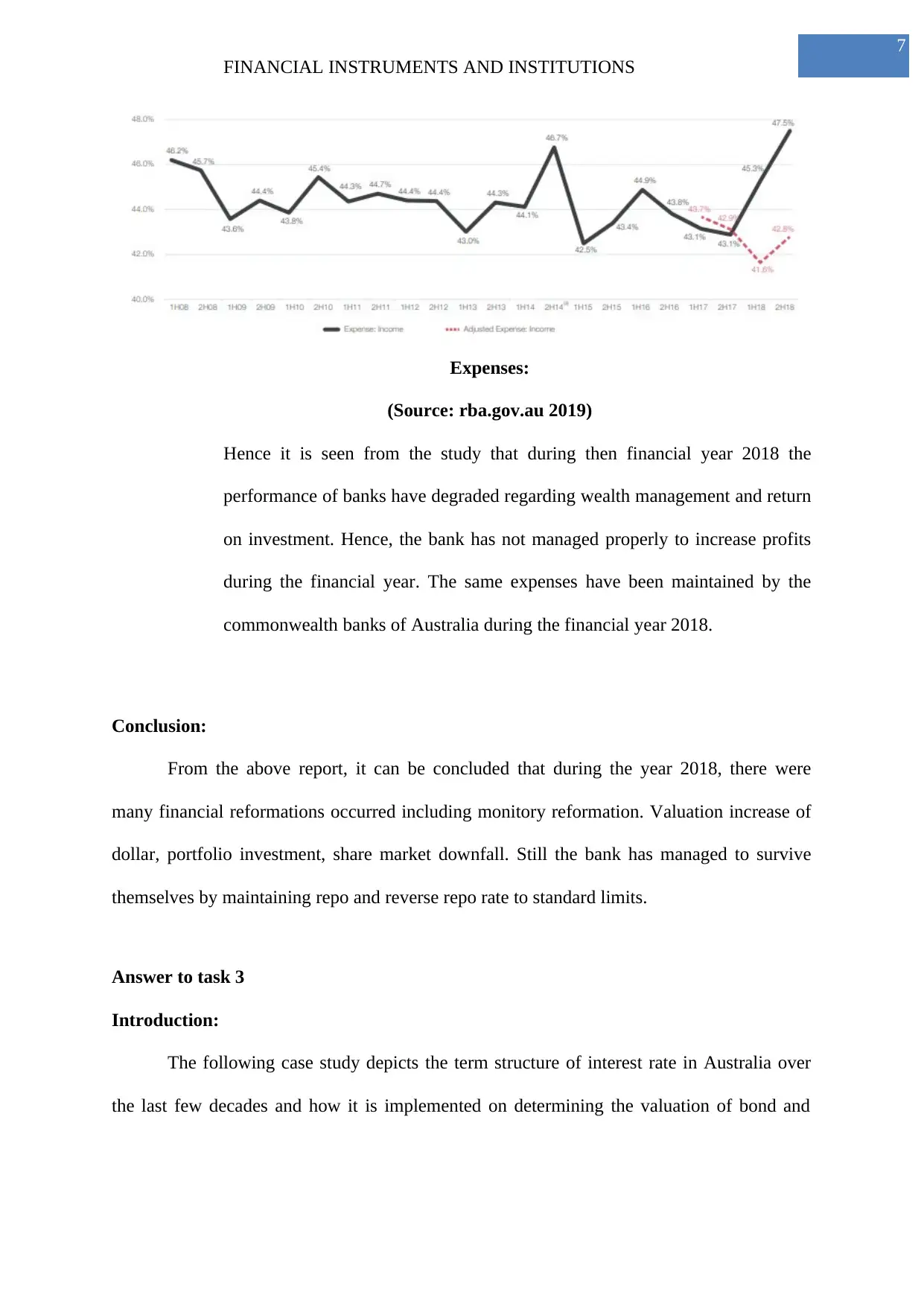
7
FINANCIAL INSTRUMENTS AND INSTITUTIONS
Expenses:
(Source: rba.gov.au 2019)
Hence it is seen from the study that during then financial year 2018 the
performance of banks have degraded regarding wealth management and return
on investment. Hence, the bank has not managed properly to increase profits
during the financial year. The same expenses have been maintained by the
commonwealth banks of Australia during the financial year 2018.
Conclusion:
From the above report, it can be concluded that during the year 2018, there were
many financial reformations occurred including monitory reformation. Valuation increase of
dollar, portfolio investment, share market downfall. Still the bank has managed to survive
themselves by maintaining repo and reverse repo rate to standard limits.
Answer to task 3
Introduction:
The following case study depicts the term structure of interest rate in Australia over
the last few decades and how it is implemented on determining the valuation of bond and
FINANCIAL INSTRUMENTS AND INSTITUTIONS
Expenses:
(Source: rba.gov.au 2019)
Hence it is seen from the study that during then financial year 2018 the
performance of banks have degraded regarding wealth management and return
on investment. Hence, the bank has not managed properly to increase profits
during the financial year. The same expenses have been maintained by the
commonwealth banks of Australia during the financial year 2018.
Conclusion:
From the above report, it can be concluded that during the year 2018, there were
many financial reformations occurred including monitory reformation. Valuation increase of
dollar, portfolio investment, share market downfall. Still the bank has managed to survive
themselves by maintaining repo and reverse repo rate to standard limits.
Answer to task 3
Introduction:
The following case study depicts the term structure of interest rate in Australia over
the last few decades and how it is implemented on determining the valuation of bond and
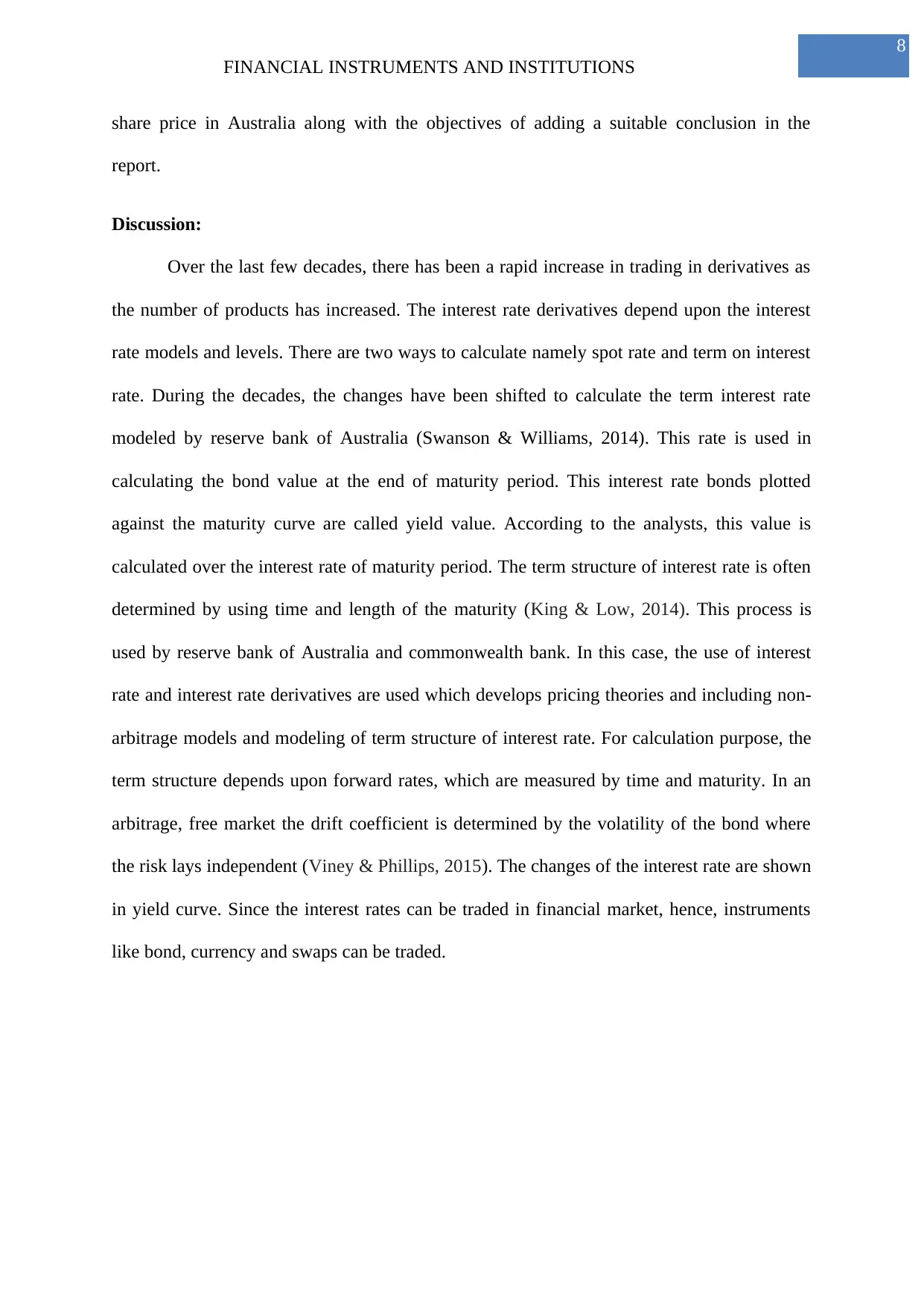
8
FINANCIAL INSTRUMENTS AND INSTITUTIONS
share price in Australia along with the objectives of adding a suitable conclusion in the
report.
Discussion:
Over the last few decades, there has been a rapid increase in trading in derivatives as
the number of products has increased. The interest rate derivatives depend upon the interest
rate models and levels. There are two ways to calculate namely spot rate and term on interest
rate. During the decades, the changes have been shifted to calculate the term interest rate
modeled by reserve bank of Australia (Swanson & Williams, 2014). This rate is used in
calculating the bond value at the end of maturity period. This interest rate bonds plotted
against the maturity curve are called yield value. According to the analysts, this value is
calculated over the interest rate of maturity period. The term structure of interest rate is often
determined by using time and length of the maturity (King & Low, 2014). This process is
used by reserve bank of Australia and commonwealth bank. In this case, the use of interest
rate and interest rate derivatives are used which develops pricing theories and including non-
arbitrage models and modeling of term structure of interest rate. For calculation purpose, the
term structure depends upon forward rates, which are measured by time and maturity. In an
arbitrage, free market the drift coefficient is determined by the volatility of the bond where
the risk lays independent (Viney & Phillips, 2015). The changes of the interest rate are shown
in yield curve. Since the interest rates can be traded in financial market, hence, instruments
like bond, currency and swaps can be traded.
FINANCIAL INSTRUMENTS AND INSTITUTIONS
share price in Australia along with the objectives of adding a suitable conclusion in the
report.
Discussion:
Over the last few decades, there has been a rapid increase in trading in derivatives as
the number of products has increased. The interest rate derivatives depend upon the interest
rate models and levels. There are two ways to calculate namely spot rate and term on interest
rate. During the decades, the changes have been shifted to calculate the term interest rate
modeled by reserve bank of Australia (Swanson & Williams, 2014). This rate is used in
calculating the bond value at the end of maturity period. This interest rate bonds plotted
against the maturity curve are called yield value. According to the analysts, this value is
calculated over the interest rate of maturity period. The term structure of interest rate is often
determined by using time and length of the maturity (King & Low, 2014). This process is
used by reserve bank of Australia and commonwealth bank. In this case, the use of interest
rate and interest rate derivatives are used which develops pricing theories and including non-
arbitrage models and modeling of term structure of interest rate. For calculation purpose, the
term structure depends upon forward rates, which are measured by time and maturity. In an
arbitrage, free market the drift coefficient is determined by the volatility of the bond where
the risk lays independent (Viney & Phillips, 2015). The changes of the interest rate are shown
in yield curve. Since the interest rates can be traded in financial market, hence, instruments
like bond, currency and swaps can be traded.
⊘ This is a preview!⊘
Do you want full access?
Subscribe today to unlock all pages.

Trusted by 1+ million students worldwide
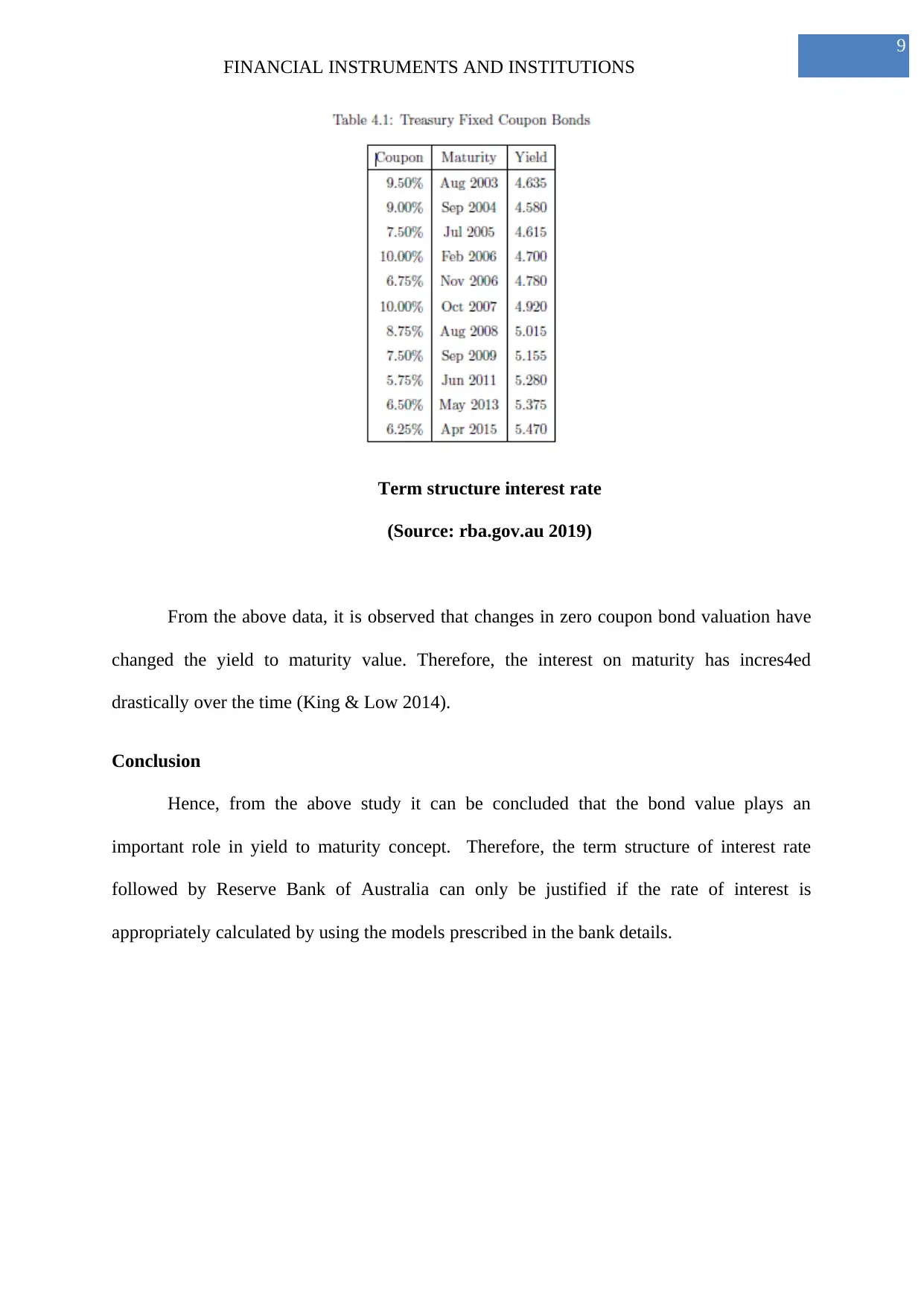
9
FINANCIAL INSTRUMENTS AND INSTITUTIONS
Term structure interest rate
(Source: rba.gov.au 2019)
From the above data, it is observed that changes in zero coupon bond valuation have
changed the yield to maturity value. Therefore, the interest on maturity has incres4ed
drastically over the time (King & Low 2014).
Conclusion
Hence, from the above study it can be concluded that the bond value plays an
important role in yield to maturity concept. Therefore, the term structure of interest rate
followed by Reserve Bank of Australia can only be justified if the rate of interest is
appropriately calculated by using the models prescribed in the bank details.
FINANCIAL INSTRUMENTS AND INSTITUTIONS
Term structure interest rate
(Source: rba.gov.au 2019)
From the above data, it is observed that changes in zero coupon bond valuation have
changed the yield to maturity value. Therefore, the interest on maturity has incres4ed
drastically over the time (King & Low 2014).
Conclusion
Hence, from the above study it can be concluded that the bond value plays an
important role in yield to maturity concept. Therefore, the term structure of interest rate
followed by Reserve Bank of Australia can only be justified if the rate of interest is
appropriately calculated by using the models prescribed in the bank details.
Paraphrase This Document
Need a fresh take? Get an instant paraphrase of this document with our AI Paraphraser

10
FINANCIAL INSTRUMENTS AND INSTITUTIONS
FINANCIAL INSTRUMENTS AND INSTITUTIONS
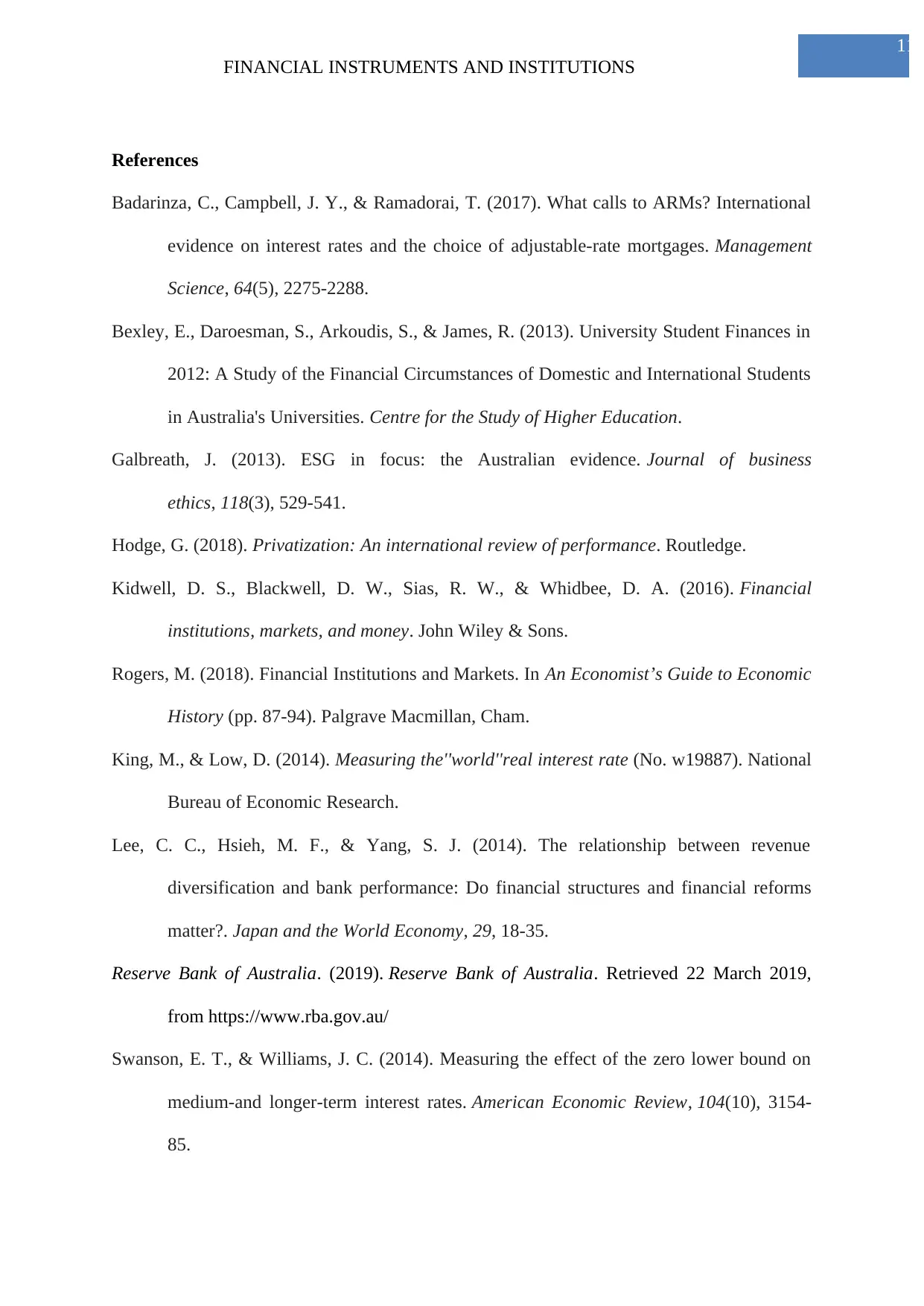
11
FINANCIAL INSTRUMENTS AND INSTITUTIONS
References
Badarinza, C., Campbell, J. Y., & Ramadorai, T. (2017). What calls to ARMs? International
evidence on interest rates and the choice of adjustable-rate mortgages. Management
Science, 64(5), 2275-2288.
Bexley, E., Daroesman, S., Arkoudis, S., & James, R. (2013). University Student Finances in
2012: A Study of the Financial Circumstances of Domestic and International Students
in Australia's Universities. Centre for the Study of Higher Education.
Galbreath, J. (2013). ESG in focus: the Australian evidence. Journal of business
ethics, 118(3), 529-541.
Hodge, G. (2018). Privatization: An international review of performance. Routledge.
Kidwell, D. S., Blackwell, D. W., Sias, R. W., & Whidbee, D. A. (2016). Financial
institutions, markets, and money. John Wiley & Sons.
Rogers, M. (2018). Financial Institutions and Markets. In An Economist’s Guide to Economic
History (pp. 87-94). Palgrave Macmillan, Cham.
King, M., & Low, D. (2014). Measuring the''world''real interest rate (No. w19887). National
Bureau of Economic Research.
Lee, C. C., Hsieh, M. F., & Yang, S. J. (2014). The relationship between revenue
diversification and bank performance: Do financial structures and financial reforms
matter?. Japan and the World Economy, 29, 18-35.
Reserve Bank of Australia. (2019). Reserve Bank of Australia. Retrieved 22 March 2019,
from https://www.rba.gov.au/
Swanson, E. T., & Williams, J. C. (2014). Measuring the effect of the zero lower bound on
medium-and longer-term interest rates. American Economic Review, 104(10), 3154-
85.
FINANCIAL INSTRUMENTS AND INSTITUTIONS
References
Badarinza, C., Campbell, J. Y., & Ramadorai, T. (2017). What calls to ARMs? International
evidence on interest rates and the choice of adjustable-rate mortgages. Management
Science, 64(5), 2275-2288.
Bexley, E., Daroesman, S., Arkoudis, S., & James, R. (2013). University Student Finances in
2012: A Study of the Financial Circumstances of Domestic and International Students
in Australia's Universities. Centre for the Study of Higher Education.
Galbreath, J. (2013). ESG in focus: the Australian evidence. Journal of business
ethics, 118(3), 529-541.
Hodge, G. (2018). Privatization: An international review of performance. Routledge.
Kidwell, D. S., Blackwell, D. W., Sias, R. W., & Whidbee, D. A. (2016). Financial
institutions, markets, and money. John Wiley & Sons.
Rogers, M. (2018). Financial Institutions and Markets. In An Economist’s Guide to Economic
History (pp. 87-94). Palgrave Macmillan, Cham.
King, M., & Low, D. (2014). Measuring the''world''real interest rate (No. w19887). National
Bureau of Economic Research.
Lee, C. C., Hsieh, M. F., & Yang, S. J. (2014). The relationship between revenue
diversification and bank performance: Do financial structures and financial reforms
matter?. Japan and the World Economy, 29, 18-35.
Reserve Bank of Australia. (2019). Reserve Bank of Australia. Retrieved 22 March 2019,
from https://www.rba.gov.au/
Swanson, E. T., & Williams, J. C. (2014). Measuring the effect of the zero lower bound on
medium-and longer-term interest rates. American Economic Review, 104(10), 3154-
85.
⊘ This is a preview!⊘
Do you want full access?
Subscribe today to unlock all pages.

Trusted by 1+ million students worldwide
1 out of 13
Related Documents
Your All-in-One AI-Powered Toolkit for Academic Success.
+13062052269
info@desklib.com
Available 24*7 on WhatsApp / Email
![[object Object]](/_next/static/media/star-bottom.7253800d.svg)
Unlock your academic potential
Copyright © 2020–2025 A2Z Services. All Rights Reserved. Developed and managed by ZUCOL.





